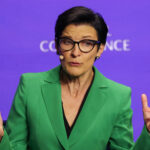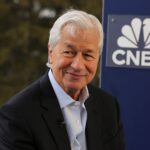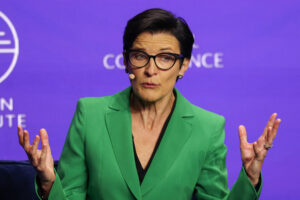
Participants
Donald M. Young; Executive VP & COO; ADT Inc.
Elizabeth Landers
James David DeVries; CEO, President & Director; ADT Inc.
Jill Sullivan Greer; Senior VP of Finance, IR & Communications; ADT Inc.
Kenneth Porpora; Executive VP & CFO; ADT Inc.
Ashish Sabadra; Analyst; RBC Capital Markets, Research Division
Brian William Ruttenbur; Research Analyst; Imperial Capital, LLC, Research Division
John Ronan Kennedy; Research Analyst; Barclays Bank PLC, Research Division
Keen Fai Tong; Research Analyst; Goldman Sachs Group, Inc., Research Division
Peter Corwin Christiansen; VP and Analyst; Citigroup Inc., Research Division
Presentation
Operator
Greetings, and welcome to the ADT Fourth Quarter and Full Year 2022 Earnings Conference Call.
(Operator Instructions)
As a reminder, this conference is being recorded. It is now my pleasure to introduce your host, Elizabeth Landers, Senior Director of Investor Relations. Thank you. You may begin.
Elizabeth Landers
Thanks, operator, and good morning, everyone. We appreciate you joining ADT’s Fourth Quarter and Full Year 2022 Earnings Call. Speaking on today’s call will be ADT’s President and CEO, James DeVries; and our EVP and CFO, Ken Porpora. After the prepared remarks, we’ll take analyst questions. Also joining us for Q&A are Don Young, EVP and Chief Operating Officer; and Jill Greer, SVP of Finance and Investor Relations.
Earlier this morning, we issued a press release and slide presentation of our financial results. These materials are available on our website at investor.adt.com. Before we start, I do need to mention that today’s remarks include forward-looking statements that represent our beliefs or expectations about future events. These forward-looking statements are subject to risks and uncertainties that could cause actual results to differ materially. Some of the factors that may cause differences are described in our SEC filings. We’ll also discuss non-GAAP financial measures on the call. The most directly comparable GAAP measures along with a reconciliation of those measures are available on our website at investor.adt.com.
And with that, I’ll turn the call over to Jim.
James David DeVries
Thank you, Elizabeth. Good morning. Thank you, operator, and thank you to everyone for joining us on our earnings call today.
ADT released our fourth quarter and full year results this morning, 2022 was a very strong year as we delivered our financial commitments strengthened our foundation and advance the transformation of our business from a traditional security company towards an innovative business poised to accelerate growth in new markets. I’d like to begin by sharing some of our growth highlights.
For the full year, we grew revenues, earnings and cash flows. Our total revenue was up 21% to $6.4 billion, generating adjusted net income of $218 million or $0.24 per diluted share. We also posted improved adjusted EBITDA, up 11% year-over-year and over $550 million of adjusted free cash flow, up 20% year-over-year. Importantly, we met our commitments to our shareholders delivering total revenue and adjusted EBITDA at or above the top end of our full year guidance and met our adjusted free cash flow guidance.
As part of growing the business, we’ve also focused on diversifying our revenue streams. To this end, during the last several years, we’ve expanded our commercial business as well as acquired a residential solar business. These actions resulted in meaningful TAM expansion in both of these fast-growing markets. Our commercial revenues grew 10% for the full year, and our solar business ended just under $800 million in revenues for 2022. For yet another consecutive quarter, our recurring monthly revenue balance, or RMR, was at a record level, and we maintained our record revenue payback of 2.1 years. Customer retention also continued to improve with gross attrition at an all-time low of 12.5%.
In addition, underscored by a record revenue payback level, capital efficiency is improving our free cash generation allowing us to invest in innovation and improve our balance sheet. We’ve now reduced our leverage ratio to below 4. We delivered these impressive results while simultaneously driving transformation. We’re effectively managing our business as we’ve transitioned from the traditional owning the alarm company toward a broader vision of owning the entire smart and secure ecosystem with our expanded commercial solar and mobile offerings, ADT is the single provider that can meet our customers’ needs at home, at work and on the go.
I’d like to highlight specifically the strategies we’re implementing to address our customers’ needs in the home. With the launch of our ADT+ platform and next-gen hardware expected this year we are putting all the pieces in place to expand (inaudible) choices for our customers.
Our vision includes customers choosing which distribution channel best meets their individual needs including choosing not only our signature in-home options but expanding other customer alternatives and choices, virtually assisted online and retail options. We’ll also be customizing our pricing and packages, offering customers options that include attractive entry price points with greater contract flexibility. This allows our customers to determine the right combination of personalized options that will provide them with the best value for their needs.
Another choice customers will have is customizing installation and service. We’re leveraging advanced technology to give customers more virtual options for sales, service and installation. To date, our virtual assistance initiatives have been a huge success as well as valued alternative to our customers, allowing ADT to deliver higher quality services at a lower cost. ADT partnerships also continue to play an important role in our transformation and 2 of our most significant partnerships are with Google and State Farm.
In distinctive yet complementary ways, both of these partnerships are expected to broaden our distribution reach and our customer offerings, giving customers even more reasons to choose ADT. Google Nest products have proven to be a great addition to our ADT offerings. After nearly a year end market, our attachment rates for video doorbells have doubled, and we’re now selling approximately 30% more cameras per home with the Google Nest product. We expect to see more uplift in device sales as we move through this year. We’ve just rolled out the integrated ADT+ app experience for our new self-install products which integrates the Google Nest product set.
We launched this just a few weeks ago, an exciting accomplishment, and we expect to do the same for our Pro Install products later this year. To support this shift, we’ve recently launched a new advertising campaign to increase the continued awareness and differentiation of our new capabilities, further igniting customer demand.
The success of our Google Nest products is also driving substantial increases in our installation revenue per subscriber, which in turn is improving our SAC efficiency. The Google Nest product addition simply said, provides us with a higher-quality customer offering. Complementing this success is our State Farm partnership with an existing customer base of approximately 14 million homeowners, State Farm has the potential to provide a significant increase to ADT’s overall reach. The partnership will also facilitate State Farm customers obtaining access to ADT’s best-in-class protection. Together, ADT and State Farm are revolutionizing the value proposition for home insurance policyholders by leveraging smart home technology to detect and mitigate losses related to water, fire, intrusion and other homeowner risks.
We expect to begin launching in a limited number of states, our first exclusive State Farm offer during the first half of this year and anticipate growth from this partnership to be reflected into 2024. We had many things to be proud about throughout 2022 and during the fourth quarter. And as we begin this year, we’re poised to navigate a challenging economic environment. While the macro environment remains uncertain, our business model has consistently demonstrated it is recession-resilient with approximately 70% of our total revenue coming from recurring revenue streams. Home improvement spending as a percent of disposable income remains at record levels, translating into stronger demand for our products.
Within our Consumer and Small Business segment, or CSB, I’m really pleased with the drivers we’re seeing for increased customer stickiness, more devices per home, higher upfront customer investments, remarkable credit score mix and higher video take rates all bode well for our future. While the demand environment appears to be steady, we’re still ensuring that if we experience any material changes in demand, we’re staying nimble and able to move quickly.
To that end, we’re streamlining our cost structure and our CSB segment. This mirrors similar actions made last year in both our commercial and solar segments, this streamlining will allow us to better focus our investments in growth and innovation while improving our speed to market and ensuring that more of our revenue growth drops to the bottom line. We’re also navigating the challenging interest rate environment we face. In the consumer business, higher rates affect attrition and are actually a net positive on this important metric given fewer relocations for existing customers.
Higher interest rates also influenced our solar business, where most purchases are financed through long-term low interest loans. This impacts both sales as customers are seeing higher rates year-over-year and also expenses as any cost to buy down the rate gets passed through to us. And of course, the biggest potential impact could be on our cash interest. And fortunately, most of our variable rate debt is hedged.
This has underscored our intent, which we shared at our Investor Day last year to actively reduce our debt levels. Our net leverage ratio at the end of 2022 was 3.9, a meaningful improvement from 4.4 just a year ago. Our goal is to get that under 3x by the end of 2025, consistent with our long-term financial plan. The final item we are focused on is the performance in our solar business. We’ve analyzed the business from top to bottom, instituting changes to improve the overall operation, customer experience and financial outcomes.
As part of this effort, we appointed longtime ADT veteran, Jamie Haenggi as our new Executive Vice President of Solar leading this growing segment. While these changes have improved results in ADT Solar, we know we still have work ahead of us to drive and sustain the level of performance we expect this segment of our business to deliver.
So in closing, we’re optimistic for 2023. We have a recession resilient business model and a plan to mitigate the challenges we may face in these uncertain economic times. We have 2 meaningful consumer growth catalysts and our partnerships with Google and State Farm and line of sight to growing revenues, earnings and cash flows in the year ahead. Our commercial business is thriving, and we have action plans in place to capitalize on the growth available to us in the solar market.
We have a strong plan and commitment to meeting both our 2023 objectives and the 2025 goals we laid out at Investor Day just a year ago. I will now turn the call over to our CFO, Ken Porpora, who will take you through the details of our financial results, including guidance for 2023.
Kenneth Porpora
Thank you, Jim, and thank you, everyone, for joining our call today.
As Jim mentioned, we have delivered on our financial objectives for 2022 and have clear momentum across each of our business segments. I’m excited with these results delivered by our team. Total company revenue was $1.6 billion for the quarter and $6.4 billion for the full year, up 21% versus prior year, including the benefit of our solar acquisition. Excluding solar, our revenue grew approximately 7% in 2022. Our recurring monthly revenue, or RMR, from our subscriber rates grew to $374 million or up 4% year-over-year, a record for the company and a strong reflection of the benefits of our higher average pricing, growth initiatives and improved customer retention.
This stronger revenue translated into higher adjusted EBITDA, which for the full year was $2.45 billion, up 11% versus prior year. Adjusted net income was $92 million or $0.10 per share in the fourth quarter, an improvement from a loss of $25 million last year. For the full year, we delivered adjusted net income of $218 million or $0.24 per share, representing our first full year positive adjusted net income since IPO.
Moving to our segment highlights. Our Consumer and Small Business, or CSB, segment delivered total revenue of $1.1 billion in the fourth quarter. And for the full year, this segment delivered $4.4 billion in revenue, an increase of 6% or $233 million versus last year. This performance was driven primarily by a 5% increase in monitoring and related services revenue resulting from higher average pricing, subscriber growth and improved customer retention that I referenced earlier. CSB Adjusted EBITDA increased by $204 million or 10% for the full year and was driven by the increased revenue combined with cost efficiencies, EBITDA margin in 2022 expanded year-over-year by 200 basis points. Our virtual service program is continuing to drive high levels of customer satisfaction and significant cost savings.
Since launch in 2021, we have completed over 1 million virtual assistance appointments. Nearly 40% of all service requests in 2022 were satisfied virtually, which drove a reduction in net service cost of 8% despite year-over-year growth in our subscriber base.
Strong demand for the Google Nest products has been an accelerator for our SAC efficiency and a record revenue payback of 2.1 years. Just a year ago, our revenue payback was 2.3 years. Our installation revenue in our direct residential business exited Q4 over $1,300 per home, up 21% year-over-year.
Turning to our Commercial segment. We delivered total revenue of $328 million in the fourth quarter, up 15% versus prior year. And for the full year, the commercial team delivered $1.2 billion in revenue. Our commercial sales and installation revenue was strong in the fourth quarter, and we are beginning to turn the backlog from earlier in the year to revenue. Installation backlog remains robust at $420 million, providing a continued pipeline for future revenue and margin. This strong revenue performance drove adjusted EBITDA of $127 million for the year, up 32% with expanded EBITDA margins for both the quarter and full year.
I am very pleased with the momentum we have in this segment. Our Solar segment posted a revenue of $200 million in the fourth quarter and $786 million for the full year. As Jim mentioned, we’re taking actions to improve operating margins in our solar business including improvements in scheduling and labor planning, workforce rightsizing and pricing adjustments. We expect these actions to drive improvement in profitability in 2023.
Turning our attention to cash flow. Adjusted free cash flow was $269 million in the fourth quarter and $558 million for the full year, in line with our guidance range and up 20% versus prior year. Strong EBITDA growth in our CSB segment and improved capital efficiency helped us overcome a shortfall in our solar segment. Our improved efficiency enabled us to grow our ending RMR by 4% with a 12% year-over-year decline in subscriber acquisition spend, which you can see in our record 2.1 year revenue payback. We have also been focused on strengthening our balance sheet. Our actions this year have driven our leverage below 4x, an important step in our path to reduce that ratio at or below 3x by the end of 2025.
Our net leverage ratio now stands at 3.9x, down from 4.4x at year-end 2021. We expect to reduce our net debt balance by more than $200 million this year. As part of this effort, we have given notice to holders that we will repay the upcoming 700 million 2023 maturity with the 600 million senior secured Term Loan A facility we closed on last year, along with cash on hand. Following this repayment, we have no meaningful maturities left this year and will turn our focus to addressing the $750 million due next year with manageable debt maturities, limited variable rate exposure and our strong recurring revenue mix we are well positioned against rising interest rates.
And finally, turning to guidance. We expect momentum in all segments of our business to overcome macro trends and result in growth in revenue, earnings and cash flows in 2023. More specifically, we expect total revenue of $6.6 billion to $6.85 billion, representing growth of approximately 5% at the midpoint. With margin expansion in all 3 segments, this top line growth translates to adjusted EBITDA of $2.525 billion to $2.625 billion, also representing growth of approximately 5% at the midpoint and in a newly added guidance metric, we are also forecasting adjusted earnings per share of $0.30 to $0.40 for the year versus $0.24 in 2022.
To help with the transition for modeling EBITDA to EPS, and we’d like to provide some additional detail on selected 2023 expenses. We expect our G&A expense to decline by more than $200 million year-over-year as we continue to see the benefits from wind-down of purchase-related accounting. However, this G&A benefit will almost entirely offset by the combination of higher book interest expense and higher tax expense. For modeling purposes, we are using a 28% tax rate assumption.
Turning to cash flow. We expect adjusted free cash flow in 2023 of $525 million to $625 million, which includes a roughly $180 million year-over-year headwind from cash interest. However, we do have a meaningful portion of our variable rate debt hedged with the benefit of the hedge realized outside of adjusted free cash flow. At current rates, those interest rate swaps are expected to be approximately $75 million benefit to financing cash flow for 2023. As a result, our adjusted free cash flow, including the benefit of interest rate swaps is expected to be $600 million to $700 million or growth of approximately 20% at the midpoint. And you will recall that our quarterly cash flows aren’t even for a variety of reasons particularly the timing of interest payments, which are much higher in the first and third quarters, with the first quarter typically the lowest cash-generating quarter for ADT. As an example, for the full year 2022, our adjusted free cash flow grew by 20% year-over-year to $558 million, while the first quarter of 2022 was negative.
As we transition to Q&A, I’d like to share my thanks to our employees and dealer partners for all they have done to enable our progress and these results. I am confident that we are on a path to achieve our 2023 guidance illustrating continued progress towards our 2025 long-term goals. Operator, please open up the call to questions.
Question and Answer Session
Operator
(Operator Instructions)
Our first question comes from the line of George Tong with Goldman Sachs.
Keen Fai Tong
You have plans to launch offers to state foreign policyholders in select markets in 2Q of this year. Can you discuss the timeline for when you expect to more broadly launch State Farm? And what ballpark the impact you expect this will have on revenue and free cash flow performance?
James David DeVries
Thanks, George. It’s Jim. I appreciate the first question here. At a high level, just to set the question up the vision for the State Farm relationship is to really transform homeowners insurance from purely restoration to include prediction and ultimately, prevention to avoid losses. And the first offering that we’re going to market with is called Circle Protection. And the objective there will be to provide State Farm customers an offering that is centered on preventing fire, intrusion and water claims. We will go to market in Indiana in late March. We have Pennsylvania and Illinois as fast follows, where we’re testing and learning this Circle Protection offering, working with the agents to get it in distribution. I think we have 6 — about a half dozen states after those first 3 that are on the docket for rollout throughout the rest of 2023. And then the intent is to go more broadly across the country into 2024. Teams are working together every day. We’re excited to get in market in Indiana. And as I said, that will be late March, possibly early April for that launch.
Keen Fai Tong
Got it. That’s helpful. You discussed the impact that the Google partnership has had on [Nest] Doorbell attach rates, Nest camera growth and overall residential installation revenue per unit. Can you elaborate on how much additional lift you would expect from Google in the years ahead? And what inning the Google partnership is currently in with respect to its ramp cadence.
James David DeVries
Yes. I mean, we continue to feel great about the partnership with Google. Our marketing teams, as you know, George, are working together for a co-branded campaign. We’ll be going to market as ADT+ Google. The teams have developed some excellent content recently. The Google Success funds were going to be tapping into for the first time this quarter, and those success funds, that first $50 million tranche, we anticipate, receiving in 2023. The large majority of those funds will be invested in upper-funnel advertising. And then, George, on the product front, we feel great to be offering Google Nest products. Our installation revenue per new install was just a tick above $1,300 in the fourth quarter that is largely due to having Google in our lineup. So we feel good about the marketing. We feel good about the relationship overall and access to those Google Success funds. And then from a product perspective, we’re pleased with the products. Our customers are pleased with the products, and we’re seeing record levels of installation revenue per.
Operator
Your next question is from the line of Peter Christiansen with Citi.
Peter Corwin Christiansen
Nice trends all around. Jim, I was wondering if you can talk a little bit more about the setup in the housing market that we’re all seeing right now. I guess you are seeing some trade down at some of the home improvement retailers. And I know you’re seeing higher attach rates. It’s contributing to lower attrition, things of that nature. I just wanted to point out, have you seen any issues as it relates to pricing trade down, any of those impacts given where we are in the housing cycle.
James David DeVries
Thanks for the question, Pete. So far, so good. We, for sure, have some pressure on gross adds because homes that are built can’t have a system installed. But overall, consumers are spending on home improvement, as I just mentioned to George, our installation revenue has been on a tear, just about linear improvement over the last 5 or 6 quarters. I think if we look back just a couple of years, that IRPU was at about $700. And as I mentioned, finished Q4 at $1,300.
Importantly, from an attrition perspective, about 40% of our attrition is due to movers and with a softer housing market and fewer relocations, the net is a benefit to us. We look at some pressure, as I said, on new adds, but far and away the benefit from improved retention advantage of ADT.
Peter Corwin Christiansen
That’s helpful. And then I wanted to dig a little bit into the commercial backlog, which really grew at a nice clip this quarter, I think up 20%, RMR, up 35%. Just if you could talk about some of the areas where you are seeing some positive momentum there, maybe by particular real estate verticals, so on and so forth. But also can you just chat about the supply issues? Are those largely alleviated right now?
James David DeVries
Yes. The momentum in this business is fantastic. The capabilities that we’re building in new verticals, energy, education, government have been strong for us. really hitting on most all cylinders. We’re doing some really interesting work in innovation around interior robots and drones, have some customer pilots in place. So at a high level, Pete, we feel great about the commercial business, specific to the supply chain, we’re not out of the woods. I’d say, I think the team would describe the environment is a bit better now than in the summer months of 2022. We’ve had some parts come in, so we’re able to chip away at that backlog a little bit. But I’d say — I’d probably characterize it as improving, but not back to normal quite yet. I think we anticipate, as 2023 goes on for the parts situation to get better and better for us.
Operator
Your next question is from the line of Brian Ruttenbur with Imperial Capital.
Brian William Ruttenbur
First of all, on attrition, you talked a little bit about what’s going on? What is in your guidance in terms of attrition in 2023. Do you expect it to be at these levels? Do you expect some improvement in attrition. There’s a lot of moving parts. I want to understand what your projections are.
Kenneth Porpora
Brian, it’s Ken Porpora. Thanks for the question. we’re not specifically guiding to attrition. When we think about some of the high-level figures that we’ve shared in an extra slide in our deck, the predictor that we have going on with the new attributes that customers are joining are really excited about the new visits that we’re adding and the proposed tickets, whether it’s more devices per home, the higher IRPU that Jim mentioned, higher video take rates, all that’s building off for the future. The relocation market move market, tough to predict. So I think holding serve in ’23 from an attrition perspective kind of is generally kind of what we’re thinking, but we’re not giving specific guidance for the metric. We think about it at a high level that we’re driving the indicators and factors that will drive long-term retention and the piece that we don’t control is the relocation and move market. We’re really excited about the trends that we’ve seen here and even a slight downtrend in the delinquencies that we’d like to see with our high level of credit scores in our portfolio.
Brian William Ruttenbur
Okay. So what I heard is that probably the likelihood is going to be flattish attrition is what we should be thinking along those lines, though it could go a fraction of a point either way. Is that a correct summary?
James David DeVries
I think that’s fair, Brian. Super tough to predict. But all of the lead indicators that Ken mentioned really bode well for us. The devices — I think, I shared this on the last call, the number of devices in a system correlates with retention. And our devices that are 10 or more devices in a system is about double right now than it was a couple of years ago. Ken mentioned an uptick in credit scores, service backlog near record low. We’re getting more sophisticated on our own save offers. And so while we’re planning to hold serve come in right around where we are now, where we’ve got some cost for optimism given the positive lead indicators.
Brian William Ruttenbur
Great. And then as a follow-up on the Google rollout on ADT+, I believe the plan was rolling out starting in the first quarter. When do you expect it to be fully rolled out for all new customers coming on board? Is it going to be 2023, beginning of 2024, maybe you can give us kind of some rough guidelines.
James David DeVries
You bet. So the way that we’re staging it is that the self-install or DIY product with Google is now launched. And that’s with the integrated app that you’re familiar with, Brian, Later this year, very late third quarter, maybe fourth quarter the intent is to roll out the product offering for our professional install product as well. So DIY is out and we’ll say, Q4 for DIFM.
Brian William Ruttenbur
Great. And then just one other quick question on solar. Are you seeing anything with the economy that’s slowing adoption of solar? Or are you on plan for seeing an improvement kind of year-over-year from 2022 levels.
James David DeVries
Yes. A lot of moving parts here. The housing market, the overall economy Inflation Reduction Act provides a bit of a tailwind. And I’d say [net], it’s probably a little softer demand than it might have been a year ago. But yes, we’re still long-term bullish on solar. I mentioned this on our last call. I’m pleased with the progress the team is making. Jamie’s leadership is fantastic for us, but there’s a lot of work to do here. And so I’m bullish on 2023 and even more so as we continue to set the operating foundation to scale this business to size.
Operator
Your next question is from the line of Manav Patnaik with Barclays. Manav, please go ahead, your line may be on mute. Okay. We’ll move on to the next question and it’s from the line of Ashish Sabadra with RBC Capital Markets.
Ashish Sabadra
I just had a multipart question about the 2025 goals. I’ll just ask them upfront. So the like when we look at the midpoint of the ’23 guidance and the 2025 goals, it implies like 20% CAGR for revenue and 24%, 25% CAGR for free cash flow. So can you just talk about how should we think about that trajectory going forward? What will drive that kind of strong momentum and maybe some of the details that you provided, but how important is Google and State Farm in helping deliver on those goals.
Donald M. Young
Sure. Thanks for the question, Ashish. They’re coming off the back of our rate to 2022, I think our guidance for ’23 is 5% revenue, 5% EBITDA and 20% of free cash flow growth. So your question really is, how does that compare to our long-term growth. It’s not exactly linear, but I think we think it’s a great milestone to step in the right direction there. I think the revenue number you quote is probably a bit high versus what we shared at the Investor Day, but I think the way to look at it is a little bit more growth in the back end from the solar business, that base matures more in ’24 and ’25. The consumer business and the commercial business coming off very strong in 2022. We’re excited with that growth as well. So I think while it’s not linear, it’s a step certainly in the trajectory for our ’25 goals. And we still are aligned with those 2025 goals, things like $10 [billion] in revenue with $3 billion in EBITDA, taking our net leverage ratio to under 3. Some of those factors — were some of the key factors. We’re paying out $1 billion of debt, some of our commitments and our long-term goals.
Ashish Sabadra
That’s very helpful color. And if you don’t mind, if I can just follow up on that question around free cash flow as well. How do we think about the drivers for free cash flow going forward?
Donald M. Young
Yes, sure. You’ll see our guide this year is $600 million to $700 million with including the benefits of the interest rate swaps. So a midpoint of $650 million, which represents about 20% year-over-year growth versus 2022. Our overall commitment for 2025 implied by $1 billion of adjusted free cash flow, so we think we’re on that pace, and we like that year-over-year growth consistent with the 20% that we grew in 2022. I think we’ve proven in ’22 the ability to deliver the cash flow, the movements in our SAC year-over-year and the revenue payback have us showing a clear line of sight to [generate] those goals, but especially the SAC, which is our biggest expense, biggest cash output. We really like the revenue payback numbers are playing up. And some of the installation revenue is a big driver of that, especially in the residential business. So when you add all those factors together, it makes us feel good about the guidance on our way to the long-term goal.
Operator
This concludes the Q&A session of today’s call. I will now turn the call back over to the company’s CEO, Jim DeVries for closing remarks.
Jill Sullivan Greer
And sorry before closing as we have one more question from Manav, if you could bring him back in.
John Ronan Kennedy
This is Ronan Kennedy on for Manav. There’s been a lot of questions on specific drivers by business. But can I just read how do you recap the underlying assumptions and what the guidance contemplates from a (inaudible) standpoint, assuming a lower volume of housing relocations and higher interest rates, but what the broad macroeconomic assumptions are? And then also, any help on how to think about sequential growth in margins given consideration to seasonality, et cetera, for 2023?
Donald M. Young
Can you repeat the last part of that about the seasonality, I kind of caught the rest of it though. The last part of your question — can you repeat the last part of your question about seasonality.
John Ronan Kennedy
Yes. Yes. Just with regards to sequential growth in margin and how to think about that for in consideration of your guidance for full year ’23 with any impacts of seasonality.
Donald M. Young
Got it. Okay. So overall, how do we think about ’23 in the form of what’s going on with the macro fees? I mean, as Jim mentioned, there’s a bunch of different variables. As I think about the consumer business, while the home market rebound may be starting up, let’s assume it just flattened and existing is, again, that tends to be a net positive for us given the greater stickiness and the greater attachment to recurring revenue. Overall, to some of the pricing that we’re seeing in the market.
We’ve had some good trends, especially on the IRPU or our revenue per unit in the home. So if you think about the consumer business, we see the bucking most of the trends with the macro, given the customer portfolio that we target. The commercial business, again, given a robust backlog of over $420 million. We feel really strong about the new verticals that we’re in as well as the ability to knock down that backlog. And on the solar business, while there are a couple of headwinds related to inflation costs and interest rates, the Inflation Reduction Act as well as higher utility expenses tend to bolster that business as well.
So lots of pros and cons when I step back when we think about our guide in the form of macro, I call it generally neutral given the markets that we plan. On a sequential basis and kind of how 2023 looks, the only thing to kind of keep in mind is, I think solar is a little more back-end loaded generally based on how we’re improving that business. I think the timing of our free cash flow, as I mentioned in the prepared remarks, Q1 tends to be a little low for us and it kind of accretes throughout the year. So I think 2022 is a good example of how our primary free cash flow generally comes in through the year. So I think about the free cash flow along all those lines of our 2022 patterns.
John Ronan Kennedy
That’s very helpful. Appreciate it. And then may I just confirm you had referred to streamlining the cost structure and CSB and reference initiatives in commercial and solar last year. Could you just recap what those were for commercial and solar in the prior year and what you expect them to be for CSB and the potential impact?
Donald M. Young
Sure. Last year, kind of put it in 2 categories. One was, get some labor force rightsizing and the second piece was pricing. And we were pretty aggressive in both areas. So we’ve had the opportunity in our consumer business that the trends have been pretty solid, as you can see from the metrics we put out last year and have guided to in 2023. So I would think of this more as pruning around the edges, sharpening our cost buckets for the consumer business, getting a little bit sharper in our pricing, but also rightsizing some of the pieces of the workforce. So I think a bit more as pruning versus the more aggressive actions we took in the commercial and solar business.
Operator
And at this time, there are no further questions. I will now turn the call over to the company’s CEO, Jim DeVries, for any closing remarks.
James David DeVries
Great. Thank you, operator, and thanks, everyone, for taking the time to join us today. As you heard, ADT is effectively growing our business. We’re driving innovation, building brand loyalty and improving our capital efficiency. We’ve got great momentum in the business with catalysts for growth in State Farm and our Google partnerships. We’re looking forward to a strong 2023. I’d like to extend my appreciation to our ADT employees and dealer partners for an outstanding quarter and outstanding year. Our results are a direct reflection of your collective efforts. Thanks again, everyone, for joining the call, and have a great day.
Operator
This does conclude today’s conference call. We thank you for your participation. You may now disconnect.











